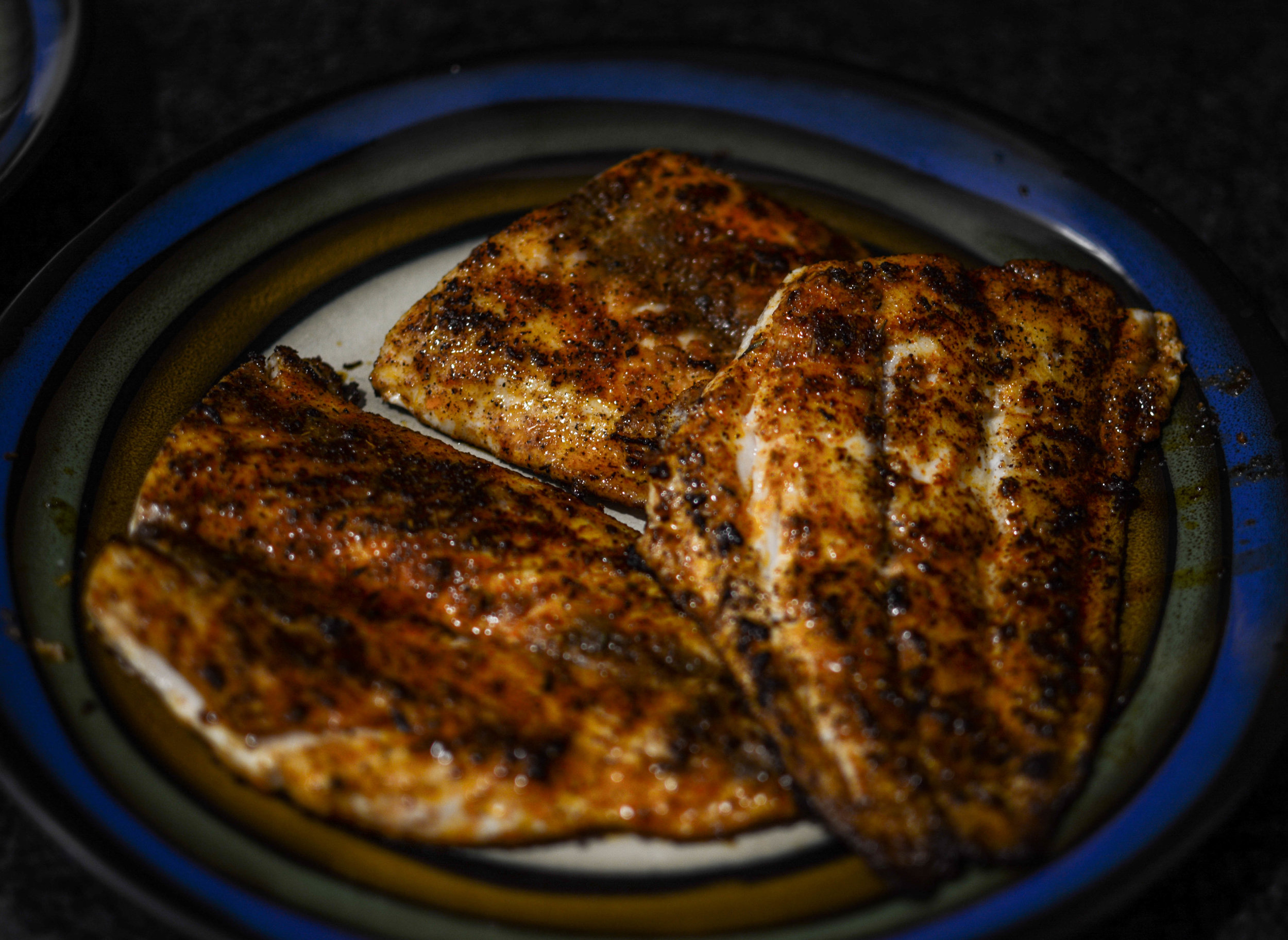BLACKENING
Blackening is an absolutely perfect way to begin developing a skill set for fish cookery. It is quick, easy, foolproof, versatile, and incredibly delicious. For those who are a little squeamish about fish, it is heavily spiced and the texture is often more similar to chicken or pork than to most other fish preparations. It uses a boneless, skinless fish fillet, which is easy to work with and easy to eat. Other than the amount of smoke that it produces, there is nothing intimidating about this technique.
At its core, this technique only needs four things; a piece of fish, a blackening spice, butter, and a white-hot surface. Let’s start with these basics and then expand up them as we go.
Heat your cooking surface. I prefer well-seasoned cast iron for blackening. It can be heated to blistering temperatures, the fish never sticks to it, and you can use aggressive techniques to clean it up after. This is something you will appreciate if you burn any bits of fish to the bottom of the pan. Cast iron stands up well to cooking over a wood, charcoal, or gas fire. This matters, since I highly recommend you use this technique outdoors. Blackening creates a great deal of smoke, so if you can’t be outside, make sure you turn on whatever kitchen fan you have or open some windows. If you don’t have a cast iron pan or griddle, use the thickest bottom skillet or Dutch oven that you have. Just make sure it is as hot as possible. You cannot make the pan too hot for blackening.
Prepare your fish. Blackening is traditionally done with firm white fish, but it will work for almost any fish. Here are my favorites: Redfish, White Seabass, Yellowtail snapper, Red snapper, striped bass. At least one of these should be readily available wherever you live. Of course, you can do it with something as simple as tilapia or salmon if you like. It works great with tuna or amberjack as well. Whatever fish you choose, look for fillets that are at least 3/8” thick, but less than 1” at the thickest part. With fish, the tail end is often much thinner than the head end. The more uniform the thickness from end to end, the better. The cooking time will vary depending on the thickness, so if the fillet varies dramatically from head to tail, the tail may be a little over by the time the head cooks through. Of course, if you are cooking this for yourself, that just makes a perfect opportunity to snatch an early bite while you are cooking. The fish should be cool, but not ice cold and definitely not frozen. The temperature is not that critical but it helps if it is cool enough to set the melted butter just a bit so it doesn’t all run off. I usually take my fish out about 15 minutes before I start my grill.
Season the fish. Melt a couple of tablespoons of butter per fish fillet. Make sure your fish is clean and dry. Spoon enough butter onto each fillet to coat the whole surface. Then shake on a healthy coating of blackening spice. You can make this yourself, recipe follows, but you can’t do a whole lot better that Paul Prudhomme’s Blackened Redfish Magic. I use it most of the time and it is perfect. Don’t be shy with the spice. Think of it like a dry rub on a pork butt. It needs to be enough to form a nice crust. If you go too crazy, you might end up too salty, but otherwise, there is no penalty for getting too liberal with the spice. At this point, you only need to butter and spice the top half. When you put it on the grill, you’ll put it spice side down, leaving the bare side exposed. At that point, you can butter and spice that side.
Cook the fish. When your pan is as hot as you can get it, drop the buttered and spiced fish fillet onto the surface. Press it down to make sure all of the fish is touching the pan. Thin fish will take as little as 1 minute per side. Thicker fish can take up to 5 minutes per side. Since fish cooking times vary a lot depending on size and species, it is important to learn to judge the doneness by eye instead of relying on the clock. For blackening, I try to watch the fish along the edges. When it turns from slightly translucent to opaque and white, through about ½ of the thickness, it is time to flip it. For thin fish, you’ll need to quickly put butter on the bare side and shake on the spice before you have to flip it. For thicker fish, wait a little until you are almost ready to flip. Once the fish has been flipped, watch for the rest of the fish to turn white and then look for the fish to start to flake. When it appears done all the way, insert a fork into the thickest part and turn it slightly. It is done when it flakes easily, is white all the way through, and doesn’t release any pinkish tinted liquid. Pull it off when it is slightly undercooked, as it will continue to cook a little. You can always put it back on if it is still under when you cut into it.
These are the basics of blackening. It is that simple. In just a few minutes with just a few items, you can have a deliciously prepared fish fillet. This can be served over your favorite rice or couscous. I like it with saffron rice, Spanish rice, or jasmine rice, or a nice rice pilaf. It goes well with a hearty sweet potato or a side of asparagus or broccoli. If you prefer, you can put it in a fish taco or put it on a bun for a tasty fish sandwich.







